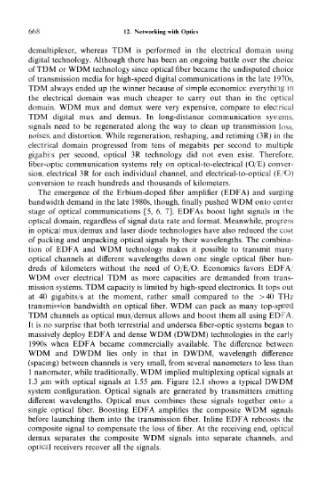Page 684 - Introduction to Information Optics
P. 684
668 12. Networking with Optics
demultiplexer, whereas TDM is performed in the electrical domain using
digital technology. Although there has been an ongoing battle over the choice
of TDM or WDM technology since optical fiber became the undisputed choice
of transmission media for high-speed digital communications in the late 1970s,
TDM always ended up the winner because of simple economics: everything in
the electrical domain was much cheaper to carry out than in the optical
domain. WDM mux and demux were very expensive, compare to electrical
TDM digital mux and dernux. In long-distance communication systems,
signals need to be regenerated along the way to clean up transmission loss,
noises, and distortion. While regeneration, reshaping, and retiming (3R) in the
electrical domain progressed from tens of megabits per second to multiple
gigabits per second, optical 3R technology did not even exist. Therefore,
fiber-optic communication systems rely on optical-to-electrical (O/E) conver-
sion, electrical 3R for each individual channel, and electrical-to-optical (E/O)
conversion to reach hundreds and thousands of kilometers.
The emergence of the Erbium-doped fiber amplifier (EDFA) and surging
bandwidth demand in the late 1980s, though, finally pushed WDM onto center
stage of optical communications [5, 6, 7]. EDFAs boost light signals in the
optical domain, regardless of signal data rate and format. Meanwhile, progress
in optical mux/demux and laser diode technologies have also reduced the cost
of packing and unpacking optical signals by their wavelengths. The combina-
tion of EDFA and WDM technology makes it possible to transmit many
optical channels at different wavelengths down one single optical fiber hun-
dreds of kilometers without the need of O/E/O. Economics favors EDFA/
WDM over electrical TDM as more capacities are demanded from trans-
mission systems. TDM capacity is limited by high-speed electronics. It tops out
at 40 gigabits/s at the moment, rather small compared to the >40 THz
transmission bandwidth on optical fiber. WDM can pack as many top-speed
TDM channels as optical mux/demux allows and boost them all using EDFA.
It is no surprise that both terrestrial and undersea fiber-optic systems began to
massively deploy EDFA and dense WDM (DWDM) technologies in the early
1990s when EDFA became commercially available. The difference between
WDM and DWDM lies only in that in DWDM, wavelength difference
(spacing) between channels is very small, from several nanometers to less than
1 nanometer, while traditionally, WDM implied multiplexing optical signals at
1.3 /mi with optical signals at 1.55 //m. Figure 12.1 shows a typical DWDM
system configuration. Optical signals are generated by transmitters emitting
different wavelengths. Optical mux combines these signals together onto a
single optical fiber. Boosting EDFA amplifies the composite WDM signals
before launching them into the transmission fiber. Inline EDFA reboosts the
composite signal to compensate the loss of fiber. At the receiving end, optical
demux separates the composite WDM signals into separate channels, and
optical receivers recover all the signals.

